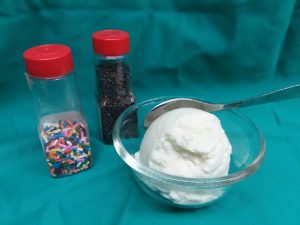
by Claire Davis | Jul 1, 2022
July is one of my favorite months of the year. Summer is in full swing, school is out, temperatures are soaring, and we celebrate Independence Day, as well as my birthday! While all those things are great, my favorite part about the month is celebrating National Ice Cream Month all month long! Who wouldn’t love a cold, sweet treat on a hot, summer day?
Did you know that one 1/2 cup serving of regular ice cream is considered a good source of calcium and phosphorous, containing 10% of the recommended daily value? While ice cream can be part of a balanced diet, its high calorie and fat content are something to consider. Ice cream is good in moderation, something I know I struggle with.

Cold, Delicious, and so many flavors! Photo source: Lyndsey B.
One of my favorite things about ice cream is the options are endless. Not only are there numerous flavors to choose from, but there are other options for how it can be made or served. “Add-ins” such as berries, chocolate sauce, sprinkles, and whipped cream can change how the base ice cream tastes. Some of the most popular flavors, such as vanilla, chocolate, cookie dough, strawberry, butter pecan, etc., do not need any add-ins though.
Types of ice cream also can be broken down into different categories:
- Regular ice cream is a frozen food product made from dairy products with at least 10% milk fat.
- Light ice cream contains at least 50% less fat or 33% fewer calories than regular ice cream.
- Low-fat ice cream contains no more than 3 grams of fat per serving.
- Nonfat ice cream contains less that 0.5 gram of fat per serving.
- Frozen custard, also known as French ice cream, contains a minimum of 10% milk fat as well as 1.4% egg yolk solids.
- Sherbets have a milk fat content only between 1-2%.
- Sorbet, also known as water ices, are similar to sherbet, but do not contain dairy.
- Frozen yogurt has a mixture of dairy ingredients such as milk or nonfat milk that has been cultured, as well as other ingredients for sweetening and flavoring.

Enjoy a scoop of ice cream in honor of National Ice Cream Month.
Photo source: UF/IFAS Northwest District
Since the kids are home from school, I am always looking for activities for them. Check out the recipe and instructions below for how to make your own ice cream in a bag at home!
Ingredients:
- 3 Zip-top bags: 2 quart-size and 1 gallon-size
- ¼ c. cream
- ¼ c. milk
- 1 Tbsp. sugar
- 3/4 tsp. vanilla extract
- 4-5 c. ice
- 1/3 c. salt (rock salt or large granules works the best)
- Toppings of your choice (sprinkles, chocolate syrup, fruits, whipped cream, etc.)
Directions:

A cool and refreshing sweet treat
Photo Source: Angela Hinkle
- Bag it! In a quart Zip-top bag, combine cream, milk, sugar and vanilla. Push out excess air and seal. (Double bag it to avoid spillage)
- Ice it! Add the ice and salt into the gallon zip-top bag. Then place the smaller, sealed bag into the ice.
- Shake it! Seal the bag and shake vigorously, 7 to 10 minutes. Do this until the ice cream has hardened. The more you shake, the quicker it hardens.
- Remove it! Remove the smaller bag from the big bag. Throw the big bag away.
- Top it! Either eat the ice cream out of the bag or spoon it into a bowl. Add your favorite toppings and enjoy!
Source:
https://fsi.colostate.edu/ice-cream/

by Heidi Copeland | Jul 11, 2018

Enjoy a scoop of ice cream in honor of National Ice Cream Month.
Photo source: UF/IFAS Northwest District
In 1984, President Ronald Reagan declared July as National Ice Cream Month and the third Sunday in July (July 15, 2018) as National Ice Cream Day! Essentially, the entire month of July is supposed to be celebrated with “appropriate ceremonies and activities” involving ice cream! Ice cream is both nutritious and delicious – eaten in moderation, of course.
However, choosing ice cream can be confusing! Categorically, ice cream is included in the frozen dessert category of the frozen food industry. This category of foods comprises groupings such as regular and low-fat ice cream, frozen yogurt, sherbets, and other frozen sweet treats.
According to the International Dairy Foods Association (IDFA), FUN ice cream facts include:
- Regular ice cream is the most popular category of frozen desserts in the U.S.
- Low-fat ice cream is the second most popular category.
- The United States eats the second largest amount of ice cream per capita.
- The average American consumed 13 pounds of ice cream in 2016.
- Ice cream companies made more than 898 million gallons of regular ice cream in 2015.
- A typical serving size is ½ cup or a scoop about the size of a tennis ball.
What really is ice cream? Real ice cream or ice-cream is a frozen sweet made from dairy products, such as milk and cream, combined with flavorings and sweeteners, such as sugar. American federal labeling standards require ice cream to contain a minimum of 10% milk fat per 1/2 cup serving and 20% total milk solids by weight. A bit of air is slowly added to this slow-stirred mixture while chilling to prevent large ice crystals from forming. A term used in processing commercial ice cream is overrun. Overrun means the liquid dairy mixture, once completely chilled, can have expanded up to double its original volume by the incorporation of air. The addition of air (although not an ingredient on the label) results in a smoothly textured ice cream free from palpable ice crystals or sandiness.
Overrun (air) helps explain the vast price discrepancy between ice cream brands. Typically, the more expensive brands generally use more and better quality ingredients and have less overrun, whereas less expensive ice cream brands tend to use the minimum amounts of ingredients required by law and more overrun. In the U.S., ice cream is sold by volume… hence, the standard serving size of ½ cup.
There are so many variations to the basic ice cream recipe. When egg yolk solids are added to ice cream, the name has to reflect this. “Frozen custard” or “French ice cream” or “French custard ice cream” is ice cream with the added egg yolk.
Premium brand ice creams tend to use a higher than standard ice cream recipe with higher fat content and more expensive, better quality ingredients… and less air.
Ice-milk is no longer made. A 1994 change in rules allows ice milk to be labeled as low-fat ice cream. Low-fat ice cream, by law, must contain 50% or less fat than a similar food. Note that the law says nothing about calories. A light ice cream may be just as high in total calories as ice cream because of the addition of other ingredients.
Frozen yogurt, made from yogurt, is a dairy product, with the addition of various sugars and flavorings. However, yogurt’s reputation for being low in calories is not always accurate and, unlike ice cream, there are no federal standards of any kind for frozen yogurt.
Gelato is a type of soft frozen dessert containing a relatively small amount of air. This makes the product dense, rich, and creamy. Gelato can be made with milk, cream, various sugars, and flavoring such as fresh fruit. In the United States, there is no federal standard definition for gelato set forth by the U.S. Food and Drug Administration.
Are sorbet, sherbet, and sherbert all the same? Despite the fact that the legal definitions of sherbet and sherbert can be used interchangeably, sherbet/sherbert is a frozen fruit and dairy product that contains anywhere from 1-2 percent milk fat from milk or cream and 2-5 percent total milk solids. On the other hand, sorbet generally implies a fruit-based frozen dessert with little to no dairy (but may contain egg white). The term sorbet is an unregulated industry standard. However, the industry wants them free from surface crustation, brittleness, syrup bleeding, and large ice crystals.
Confused yet? The frozen dessert market continues to evolve with novelty-frozen inventions made with nondairy to mimic ice cream. Welcome, delicious dairy-free almond, coconut, cashew and soymilk frozen desserts. Notice, these products are not called ice cream but non-dairy frozen desserts. Nevertheless, they are so smooth, creamy, and delicious, you might not even notice.
In 1984, when President Reagan crafted the amusing proclamation to eat ice cream, folks didn’t have SO much to choose from. You do! Enjoy a frozen treat but know what you are buying. Not all frozen treats are in fact ice cream! When you are reading nutrition labels, it is important to look at the whole picture. You can learn a lot from a label!
by Heidi Copeland | Jul 15, 2015

July is National Ice Cream Month
July: National Ice Cream Month
Why not start this month off with a treat! In 1984, President Ronald Reagan declared July as National Ice Cream Month and the third Sunday in July (July 19th) as National Ice Cream Day! Actually, the whole month of July is supposed to be celebrated with “appropriate ceremonies and activities.” Ice cream is both nutritious and delicious…… eaten in moderation of course, but it can also be confusing. Not all frozen treats are in fact ice cream!
What really is ice cream? Real ice cream or ice-cream is a frozen dessert made from dairy products, such as milk and cream, combined with flavorings and sweeteners, such as sugar. American federal labeling standards require ice cream to contain a minimum of 10% milk fat per 1/2 cup serving and 20% total milk solids by weight. This mixture is stirred slowly while chilling to prevent large ice crystals from forming. A term used in making commercial ice cream is overrun. Overrun means the liquid mixture, once completely chilled can have expanded up to double its original volume by the incorporation of air. This results in a smoothly textured ice cream free from palpable ice crystals or sandiness.
Overrun helps explain the vast price discrepancy between ice cream brands. More expensive brands normally use more and better quality ingredients and have less overrun whereas as less expensive ice cream brands tend to use the minimum amounts of ingredients required by law and more air. Thus, the weight of a half-gallon can indicate quality too.
There are many variations to the basic ice cream recipe. Reading the label of a favorite product helps the consumer learn what is in their favorite brand.
When egg yolk solids are added to ice cream the name has to reflect this. “Frozen custard” or “French ice cream” or “French custard ice cream” is ice cream with the added egg yolk.
Super premium ice cream tends to have higher than standard ice cream recipe. High fat contents and more expensive, best quality ingredients add calories and expense.
Ice milk is not a type of ice cream you see much anymore: it has been replaced by reduced fat products. Years ago ice milk was the low fat version of ice cream. Ice milk is not required to contain the standard minimum of milk fat. However, reduced fat ice cream is required by law to have 25% less fat than that particular company’s regular version. Nonetheless, calories lost here by reducing the milk fat might be made up by other added ingredients such as candy bits. Even light versions of the premium brands can have more fat and calories than plain ice cream. Again, you learn a lot from a label.
Frozen yogurts, made from yogurt, are a dairy product, with the addition various sugars and flavorings. However, yogurt’s reputation for healthfulness is not always accurate and unlike ice cream there are no Federal standards of any kind for frozen yogurt
Gelato is a type of soft ice cream containing a relatively small amount of air. This makes the product dense, rich and creamy. Gelato can be made with milk, cream, various sugars, and flavoring such as fresh fruit. Gelato is generally lower in calories, fat and sugar than ice cream. In the United States there is no standard of definition for gelato set forth by the United States Food and Drug Administration.
Are sorbet, sherbet, and sherbert all the same? Despite the fact that the legal definitions of sorbet and sherbet could be used interchangeably, there is a distinction among American frozen dessert manufacturers. Sherbet — which is alternatively spelled sherbert — is a frozen fruit and dairy product that contains anywhere from 1 percent to 3 percent milk fat from milk or cream. On the other hand, sorbet generally implies a fruit-based frozen dessert with little to no dairy — although the use of the term sorbet is unregulated industry standards want them free from surface crustation, brittleness, syrup bleeding, and large ice crystals.
Confused yet? New to the frozen dessert market are novelty frozen concoctions made with nondairy to mimic ice cream. Welcome, delicious dairy free, soy milk, coconut milk and almond milk frozen desserts. Notice, these products are not called ice-cream but are so smooth and creamy you might not even realize.
In 1984, when President Ronald Regan’s crafted the unique proclamation to eat ice cream folks didn’t have so much to choose from. You do. Enjoy a frozen treat but know what you are buying…….. You can learn a lot from a label.
http://www.icecream.com/icecreaminfo
[Code of Federal Regulations] [Title 21, Volume 2] [Revised as of April 1, 2014] [CITE: 21CFR135.110]







